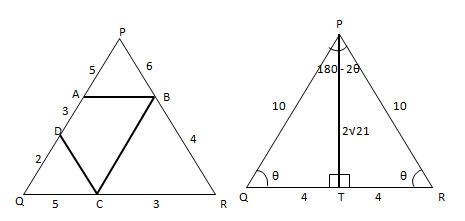Question
In the given figure, PQR is a triangle and quadrilateral
ABCD is inscribed in it. QD = 2 cm, QC = 5 cm, CR = 3 cm. BR = 4 cm. PB = 6 cm. PA = 5 cm and AD = 3 cm. What is the area (in cm2) of the quadrilateral ABCD?Solution
 We draw a Ʇ PT bisect QR PT = 2√21 BY PGT ∆ PQR = ½ × 8 × 2√21 = 8√21 Area of ∆ QDC = ½ × 2 × 5 × sin θ = ½ × 2 × 5 × (2√21/10) = √21 Area of ∆ BCR = ½ × 3 × 4 × sin θ = ½ × 3 × 4 × (2√21/10) =6√21 / 5 Area of ∆ PAB = ½ × 5 × 6 × sin (180 – 200) = ½ × 5 × 6 × sin2 θ = ½ × 5 × 6 × 2 sin θ cos θ = ½ × 5 × 6 × 2 × 2√21/10 × 4/10 = 12√21 / 5 = 8√21 – (√21 + 6√21/5 + 12√21/5) = 8√21 – (√21 + 18√21/5) = 8√21 – (5√21 + 18√21/5) = 8√21 – √21 (23/5) = 40√21 – √21 (23) / 5 = 17√21 / 5
We draw a Ʇ PT bisect QR PT = 2√21 BY PGT ∆ PQR = ½ × 8 × 2√21 = 8√21 Area of ∆ QDC = ½ × 2 × 5 × sin θ = ½ × 2 × 5 × (2√21/10) = √21 Area of ∆ BCR = ½ × 3 × 4 × sin θ = ½ × 3 × 4 × (2√21/10) =6√21 / 5 Area of ∆ PAB = ½ × 5 × 6 × sin (180 – 200) = ½ × 5 × 6 × sin2 θ = ½ × 5 × 6 × 2 sin θ cos θ = ½ × 5 × 6 × 2 × 2√21/10 × 4/10 = 12√21 / 5 = 8√21 – (√21 + 6√21/5 + 12√21/5) = 8√21 – (√21 + 18√21/5) = 8√21 – (5√21 + 18√21/5) = 8√21 – √21 (23/5) = 40√21 – √21 (23) / 5 = 17√21 / 5
In January 2022, S Somanath has been appointed as the tenth chairman of ________
The cold subarctic climate region possesses forest lands having conifers as main vegetation. These forest lands are known as:
When was the Right of Children to Free and Compulsory Education Act passed by Parliament?
TReDS is an electronic platform for facilitating the financing / discounting of trade receivables of which of the following sector?
Which of the following options accurately describes Blue Bonds?
How much additional subsidy is allocated to Fertilizers by the government of India in Union Budget FY22-23?
_____ was the son of a Chief of the Jnatrika (or Jhatrika) Kshatriya clan.
Which muscles in the skin contract to make the hairs on our skin stand up straight (goose bumps) when we are cold or frightened ?
Who won men's singles title at the 2018 US Open?
On which date does the United Nations Day, marking the anniversary of the entry into force of the UN Charter in 1945, take place?


